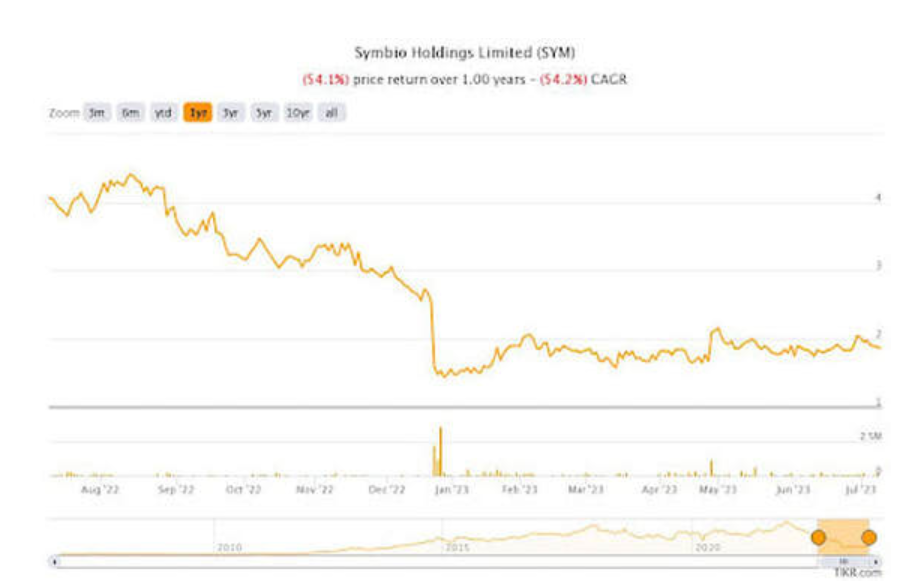Symbio Holdings (ASX: SYM) dropped a stunning 37.5% in a single session following a trading update on 20 December 2022.
The communications software provider announced a sharp decrease in its expected FY23 operating earnings (EBITDA) with a decrease in the midpoint guidance of 25% to between $26 million to $30 million. The plunge in expectation was largely due to the Communications Platform-as-a-Service (CPaaS) division where US customers had been returning excess inventory as well as a number of deals with its Australian customers taking longer than expected to finalise.

In response, Symbio has looked internally to reduce expenditure in an attempt to reduce its cost base.
At the time it announced that it would defer selected product development and projects into the second half of 2023 while also reducing discretionary spending in travel, marketing and pausing recruitment all together.
But what has happened since?
Toward the end of April 2023 the company re-confirmed its guidance to be between $26 million to $28 million citing stabilised market conditions and improving domestic and global demand. The Symbio share price has also seen a resurgence from its 52 week low of $1.34 shortly after the December update and has lifted almost 40%. Great news for short term holders although zooming out the one year and three year price performance there has been little relief.
The Company
Symbio provides communication services to software companies, telecom providers and enterprise customers globally.
It is positioning itself as a disruptor of legacy physical networks with the mission to convert customers to cloud based infrastructure and provide faster, easier ways to deliver communication services. The company is experiencing significant tailwinds following increased adoption of cloud based telephone and remote conferencing communication.
Symbio’s customers include some serious global players including Alphabet Inc. (NASDAQ: GOOGL), Microsoft (NASDAQ: MSFT), Zoom Video (NASDAQ: ZM) and Cisco (NASDAQ: CSCO) to name a few.
The company operates through three divisions which were established in the 2022 financial year as part of its “Vision 2030” strategy, these divisions are:
CPaaS – Communications Platform as a Service
The CPaaS division targets global software companies and larger infrastructure based service providers with the aim to enable calling and messaging via Symbio hosted phone numbers. As part of its strategy Symbio is targeting 100 million phone numbers on its network.
UCaaS – Unified Communications as a Service
The UCaaS division operates cloud calling services and includes partnerships with Microsoft Teams, Cisco WebEx, Twilio and other enterprise software specialists. UCaaS purchases infrastructure from CPaaS with its mission to enable the roll-out and self-service management of enterprise collaboration services across Australia and Asia-Pacific.
TaaS – Telecom as a Service
The TaaS division provides a digital platform for small Australia service providers to operate their own, fully branded, telecom and managed services business. TaaS operates under the Telcoinabox subsidiary and like UCaaS purchases infrastructure from CPaaS as well as other vendors of complementary telecom services.
Post COVID blues
Symbio was not immune to the risk-off trade that played out during 2022.
After soaring to high’s above $7 per share in November 2021 on the back of increased demand for remote communication solutions during the pandemic, the company’s share price fell, feeling the pressure of rising interest rates and inflation in a market where technology stocks were significantly out of favour.
This culminated in the December 2022 revised guidance where it was emphasised that orders were reverting back to normal pre-pandemic operating levels and a softer economy was having an impact on growth.
Looking ahead
As mentioned Symbio confirmed its FY2023 EBITDA guidance in April with the expectation that the initiatives it has put in place should continue to lower the cost run-rate in the 2024 Financial year.
The market lapped this up with a 25% share price increase in the session, appreciating the news that the expansion into Singapore, Malaysia and Taiwan could increase its total addressable market by 170% to 100 million people by 2024.
Co-Founder and CEO Rene Sugo commented:
“It is pleasing to see the global technology sector improve in Q3 and return to a growth focus. Symbio’s strong balance sheet and clear strategic vision will allow us to capitalise on the supportive mega-trends that underpin our long-term growth, both domestically and in Asia.”
Is it a takeover target?
In the small to mid-cap space of the market, there has been a significant rise in merger and acquisition (M&A) activity recently. This trend has caught our attention, and we believe it presents an opportunity worth exploring. Particularly, Symbio, currently trading at a depressed valuation, has the potential to become an appealing target for acquisition by a larger suitor.
Two prominent contenders in this potential acquisition scenario are Aussie Broadband (ASX: ABB) and Superloop (ASX: SLC). Each company brings distinct motives to the table, offering different yet compelling reasons for considering a deal with Symbio.
Aussie Broadband, having recently acquired Over the Wire (OTW), competes directly with Symbio. It appears that substantial synergies, amounting to over $10 million, could be unlocked through the proposed deal. The addition of Symbio to Aussie Broadband’s portfolio could boost its EBITDA by approximately 40%, showcasing the potential for considerable growth.
On the other hand, Superloop sees an opportunity to leverage complementary services and synergies from a potential deal with Symbio. During their recent investor day, the company emphasised the significance of M&A in their growth strategy. Highlighting their strong financial position and long-term earnings ambition, Superloop’s Managing Director, Paul Tyler, hinted at the possibility of exploring opportunities that could be “very accretive” for the company. Integrating Symbio into Superloop’s operations is estimated to increase their EBITDA by up to 80%, significantly advancing their three-year target of doubling the size of their business.
The current M&A activity in the market has led us to closely examine the prospects of Symbio and other small caps as potential acquisition targets. Symbio’s current valuation and strategic positioning could attract the attention of key players in the industry and deserves some second-level thinking.
Watch this space.


